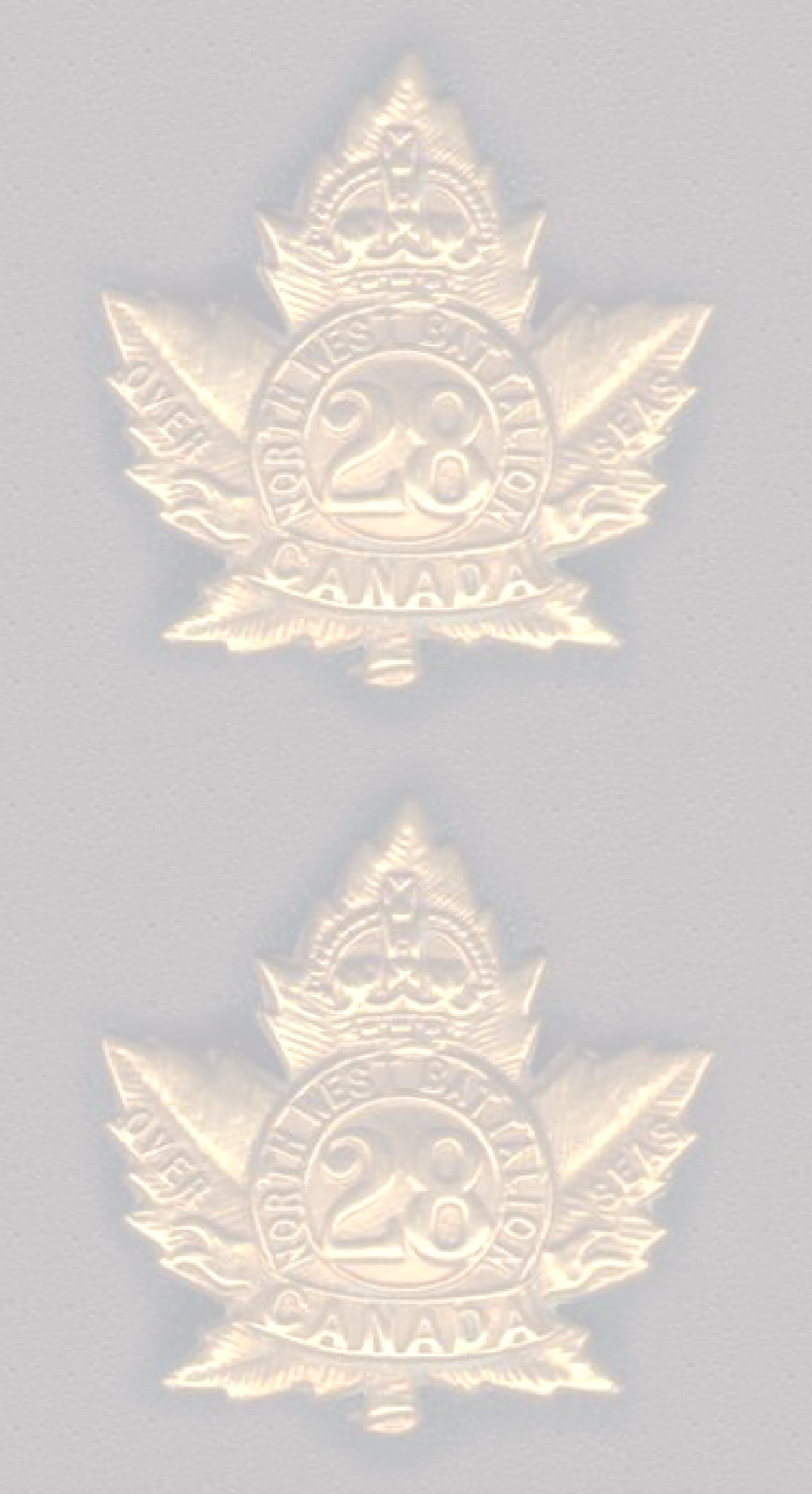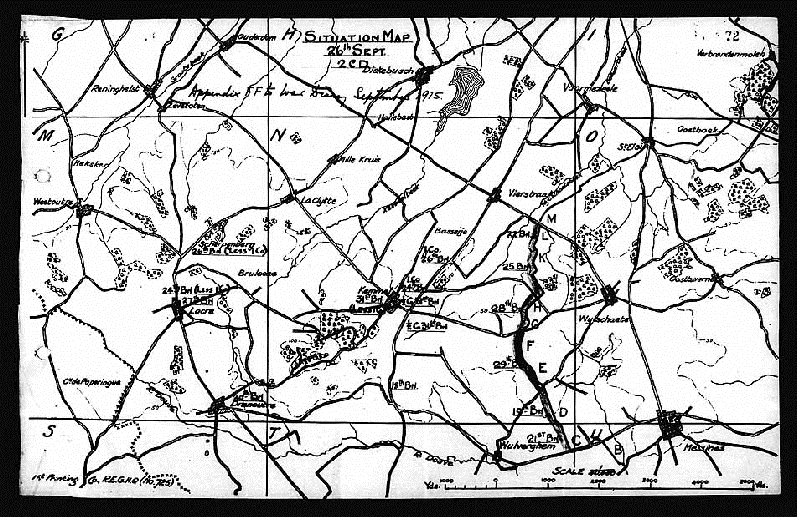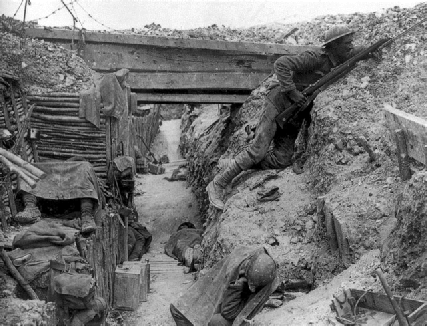
The War Diary of Lieutenant William L Hayes M C
1915—1919

WLH’s first major experience in the front line with the Battalion was at Locre near Ypres in October.
30 Sept D Coy were sent to trenches F2, F6 (r), SP9 & Regent Dugout. In trenches 7—12 October, 19—23 October and 30 October—5 Nov.
War Diary 28th Bn 8 October. ‘Bn in trenches fairly quiet all day until about 5.30 pm when enemy exploded mine under G1 and G2 [which was commanded by ‘D’ Company and Battalion Bombing Section] of our trench causing great damage to this part killing 21 men and wounding 33. A heavy bombardment immediately took place
1915 and the Battles for Ypres -
WLH signed his Attestation Papers in Winnipeg on the 5 February 1915. His health was assessed, he nominated his next of kin and was assigned to the 28th (Northwest) Battalion, D Company (many of whom were from Saskatoon area). He was almost 27 years old. The average age of a Canadian soldier in this war was 26.
According to D E Macintyre (Canada at Vimy) recruits stayed in Winnipeg throughout the winter, training and living in an indoor arena, with no equipment and no winter clothing or adequate uniforms.
The Battalion entrained for Montreal on 26 May and sailed for Plymouth, England on the SS Northland arriving there on 7 June. According to Macintyre the voyage and landing were anything if not eventful, with many excited and under disciplined young men on board.
http://www.nwbattalion.com/history1.html
War Diary 28th Bn, 23 Sept 1915 ‘The following are detailed to take a Course in use of Trench Mortars Cpl, A G Mooney, Ptes, R E Owens, J Woodhouse, W L Hayes.’
War Diary 28th Bn, 25 Sept 1915. 5.30 am ‘The party detailed to take the trench mortar course proceeded to the Trench Mortar School.’
On 11 September WLH was ordered to forfeit 4 days pay for the period 7—10 Sept inclusive and was given 96 hours detention for being absent, but there is no other information in the records. Macintyre (Canada at Vimy, pp 11-
War Diary 6th Inf Bde, 12 Sept 1915, item 101. Order No 952. ‘All N.C.O.s and Men who have qualified as Bomb Throwers and are qualified to be posted to the Grenade Co. of the Division should appear in part II Orders of the Unit to which they belong as ‘qualified as bomb throwers’ so as to permit this part of their Military History being regularly recorded.’ WLH’s qualification was listed only on his personal papers and he was not assigned to the Grenade Co. The Army would not wish to disregard any training or skill which contributed to its strength, so credit was given -
War Diary 28th Bn, 25 Sept 1915 5.30 pm ‘The battalion was ordered to parade to be addressed by Gen’l Addeson who stated that to strengthen the advance by the French Army it had been decided to withdraw the remaining troops of the First Division at present holding the left of the Canadian Corps and to place the 6th Bde in that line. He further stated that the 6th Bde would move the same evening and take over. The announcement was received with cheers from all ranks.’
http://www.1914-
Training began as soon as they arrived at Dibgate Camp near Dover. Later the training moved to Otterpool in Kent. The extensive training syllabus included, drill, digging, musketry, bayonet fighting, outpost duty training, sentry duty, scout training and patrols, map reading, reporting, laying out bivouac and outpost protection, field dressing, smoke helmets, mock attacks at section, company and battalion levels.
They were inspected by King George V on 2 September.
18 Sept 1915 they entrained for St Omer, France.

War Diary: Wonderful comment and observation from October War Diary 2nd Div.
Bits of humour: pigeons seen flying into enemy trenches…commentary congratulations enemy on improvements to their trench rations!
Casualties -
http://cefresearch.ca

Iwm.org.uk
Soldier on the fire step, others sleeping where they can
28th Bn WD 25 December: 'Our men greeted Fritz at Morning Stand To with machine gun & rifle fire, but enemy did not reply, scarcely a shot was fired during the remainder of the day, no artillery & no fraternising with the enemy, 2 companies in strong points relieved 2 companies in front lines.’ 28th Bn War Dairy There was to be no repetition of the Christmas Truce of 1914.
The ‘Morning Stand to’ also known as ‘Morning Hate’ was a daily routine in which men with fixed rifle bayonets were on the fire step of the trenches before dawn for about an hour and a half. Often small arms fire, machine guns and light artillery were aimed at the enemy trenches. Little damage was done and it was largely a waste of ammunition, but kept troops alert. It was discontinued later in the war.
1 November Heavy rain, 'Dug outs & trenches caving in badly, mud & water knee deep in trenches, large number of men ill due to exposure of wet & cold, none killed or wounded.' 28th Bn WD

on both sides but the enemy were unable to advance upon our damaged position and were eventually silenced. The work of rescuing wounded, digging them out of positions in which they had been buried was most difficult and was carried on all night being completed by the early morning.’ See map above. Note: Length of a Trench Mortar Course seems to have been about a fortnight. If this is the case, then WLH would not have been in this trench at the time.